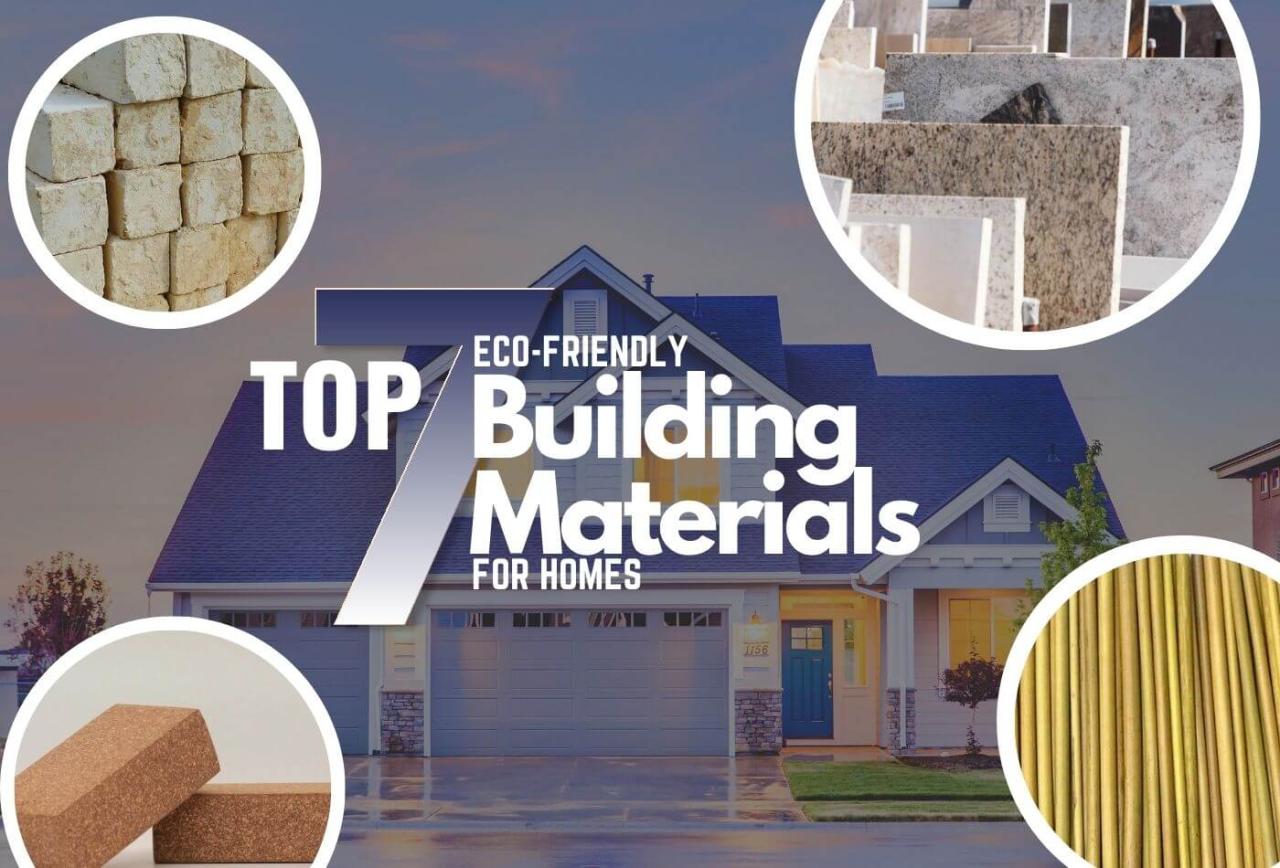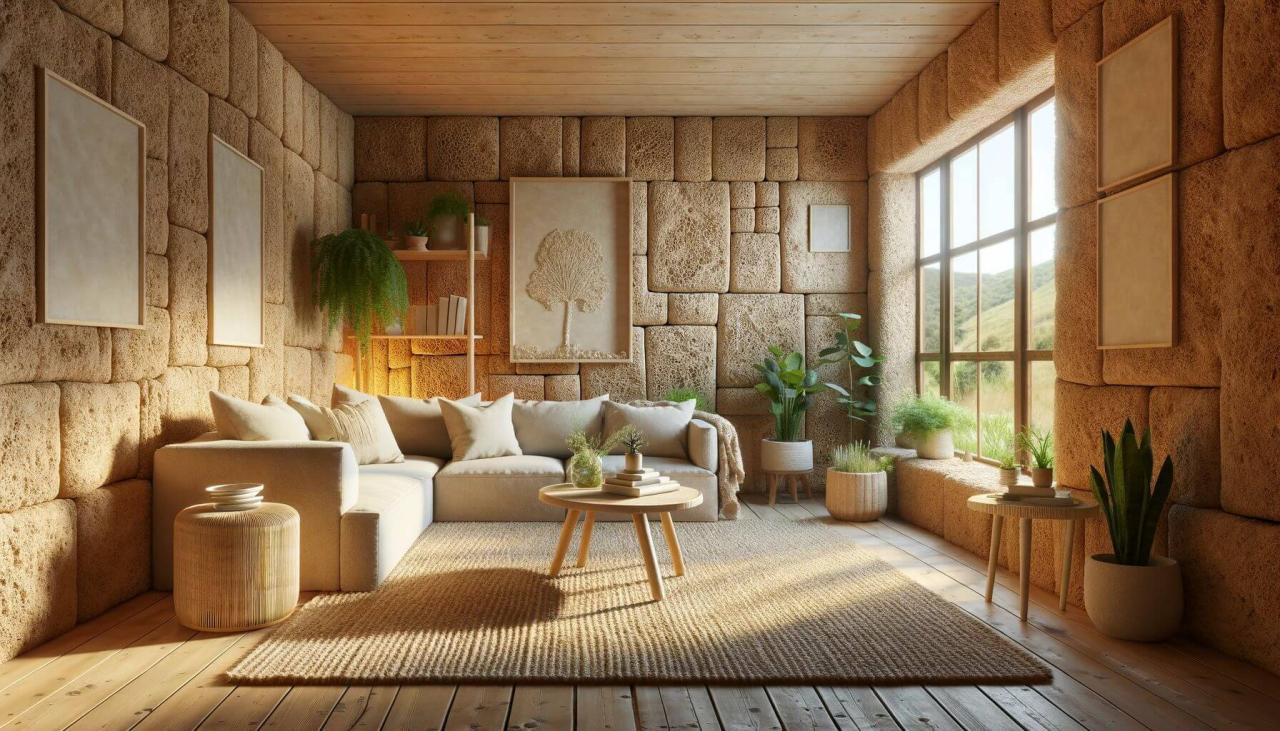Eco-Friendly Home Renovation Materials: A Sustainable Approach to Enhancing Your Living Space

Exploring the realm of eco-friendly home renovation materials opens up a world of possibilities for creating a sustainable and environmentally conscious living space. From sustainable flooring options to energy-efficient insulation, this discussion will delve into the importance of these materials and their benefits over traditional ones.
As we navigate through the different types of eco-friendly materials and their impact on home renovations, you'll gain insights into how these choices can not only enhance your living environment but also contribute to a greener future.
Eco-friendly Home Renovation Materials
When it comes to renovating your home, choosing eco-friendly materials is not only beneficial for the environment but also for your health and overall well-being. Eco-friendly materials are those that are sustainably sourced, energy-efficient, non-toxic, and recyclable or biodegradable.
Common Types of Eco-friendly Materials
There are several types of eco-friendly materials that are commonly used in home renovations:
- Bamboo: A rapidly renewable resource that can be used for flooring, furniture, and cabinets.
- Recycled Glass: Used for countertops, tiles, and decorative accents, made from recycled glass bottles.
- Reclaimed Wood: Salvaged from old buildings or structures, giving a unique and rustic look to your home.
- Cork: Sustainable and renewable material used for flooring, insulation, and wall coverings.
- Soy-based Insulation: An alternative to traditional insulation, made from soybean oil and recycled paper.
Benefits of Using Eco-friendly Materials
Choosing eco-friendly materials for your home renovations has numerous benefits:
-
Reduced Environmental Impact:
Eco-friendly materials are sustainably sourced and reduce the depletion of natural resources.
-
Improved Indoor Air Quality:
Non-toxic materials contribute to better indoor air quality, reducing the risk of respiratory issues.
-
Energy Efficiency:
Many eco-friendly materials are energy-efficient, helping to lower utility bills and reduce carbon emissions.
-
Durability and Longevity:
Eco-friendly materials are often more durable and long-lasting than traditional materials, reducing the need for frequent replacements.
-
Health Benefits:
Using non-toxic materials can improve your health and well-being by reducing exposure to harmful chemicals.
Sustainable Flooring Options

When it comes to sustainable flooring options, there are several eco-friendly materials to consider, such as bamboo, cork, reclaimed wood, and recycled glass. These materials not only help reduce environmental impact but also add a unique touch to your home.
Bamboo Flooring
- Bamboo is a rapidly renewable resource, making it an eco-friendly choice for flooring.
- It is durable and can withstand heavy foot traffic, making it suitable for high-traffic areas like living rooms and kitchens.
- Regular cleaning and proper maintenance are essential to preserve the beauty of bamboo flooring.
Cork Flooring
- Cork is harvested from the bark of cork oak trees without harming the tree, making it a sustainable option.
- It is naturally resistant to mold, mildew, and pests, making it ideal for bathrooms and basements.
- Cork flooring requires regular sealing to protect it from moisture and wear.
Reclaimed Wood Flooring
- Reclaimed wood is salvaged from old buildings, barns, and other structures, giving it a unique character and history.
- It can be used in various rooms, from bedrooms to dining areas, adding warmth and charm to the space.
- Proper installation and refinishing are crucial to maintain the integrity of reclaimed wood flooring.
Recycled Glass Flooring
- Recycled glass tiles are made from post-consumer and post-industrial glass, diverting waste from landfills.
- They are available in a variety of colors and patterns, making them suitable for kitchens, bathrooms, and even outdoor spaces.
- Regular cleaning and sealing are important to keep recycled glass flooring looking its best.
Energy-Efficient Insulation

Energy-efficient insulation plays a crucial role in a home renovation project by helping to reduce energy consumption and lower utility bills. By properly insulating a home, it can maintain a consistent temperature, prevent heat loss in the winter, and keep the interior cool in the summer.
This not only improves comfort levels but also reduces the carbon footprint of the household.
Sustainable Insulation Options
When it comes to sustainable insulation options, materials like recycled denim, sheep's wool, and cellulose stand out as eco-friendly choices. Recycled denim insulation is made from post-consumer denim scraps, providing an effective thermal barrier while reducing waste. Sheep's wool is a natural and renewable resource that is non-toxic, biodegradable, and offers excellent insulation properties.
Cellulose insulation, made from recycled paper fibers treated with fire retardants, is another sustainable option that provides good thermal resistance.
Installation Process and Energy Savings
Installing energy-efficient insulation involves fitting the chosen material between walls, ceilings, and floors to create a thermal barrier that prevents heat transfer. Proper installation ensures maximum effectiveness and energy savings by reducing the need for heating and cooling systems to work overtime.
This results in lower energy consumption, decreased utility bills, and a more sustainable home environment. Investing in energy-efficient insulation not only benefits the homeowner in the long run but also contributes to a greener, more energy-efficient future.
Non-Toxic Paints and Finishes

When it comes to home renovation, choosing non-toxic paints and finishes is essential for creating a healthy indoor environment for you and your family. Traditional paints and finishes often contain harmful chemicals that can off-gas and contribute to indoor air pollution.
Opting for natural and non-toxic alternatives can help improve indoor air quality and reduce exposure to harmful substances.
Identify Harmful Chemicals in Traditional Paints and Finishes
Traditional paints and finishes may contain volatile organic compounds (VOCs) such as benzene, formaldehyde, toluene, and xylene. These chemicals can release toxic fumes into the air, leading to respiratory issues, headaches, dizziness, and other health problems. It is important to be aware of these harmful substances and their potential impact on indoor air quality.
List of Natural and Non-Toxic Alternatives
- Milk Paint: Made from milk protein, lime, and natural pigments, milk paint is a non-toxic and biodegradable option for adding color to your walls.
- Clay Paint: Clay paint is an eco-friendly alternative made from natural clay, mineral pigments, and plant-based binders. It is breathable, mold-resistant, and free from VOCs.
- Plant-Based Finishes: Plant-based finishes, such as oils derived from plants like linseed, tung, or citrus, provide a non-toxic and sustainable way to protect and enhance wood surfaces.
Tips for Selecting and Applying Non-Toxic Paints and Finishes
- Look for paints and finishes labeled as "low-VOC" or "zero-VOC" to ensure they contain minimal or no harmful chemicals.
- Choose products that are certified by reputable organizations like Green Seal or Greenguard for their environmental and health benefits.
- Properly ventilate the area when painting or applying finishes to allow fumes to dissipate and reduce exposure to toxins.
- Follow manufacturer's instructions for application and drying times to achieve the best results while minimizing health risks.
Wrap-Up
In conclusion, embracing eco-friendly home renovation materials is not just a trend but a significant step towards a more sustainable lifestyle. By choosing these materials, you're not only improving your home but also making a positive impact on the environment.
Consider the long-term benefits and rewards of incorporating eco-friendly choices into your renovation projects.
Question Bank
What are the benefits of using eco-friendly materials in home renovations?
Eco-friendly materials are sustainable, reduce environmental impact, improve indoor air quality, and contribute to a healthier living environment.
How do you select the right eco-friendly flooring materials for different rooms?
Consider factors like durability, moisture resistance, and the room's function when choosing eco-friendly flooring materials. Bamboo is ideal for high-traffic areas, while cork is great for moisture-prone spaces like bathrooms.
What are the common harmful chemicals found in traditional paints and finishes?
Traditional paints often contain volatile organic compounds (VOCs), lead, and other toxic substances that can negatively impact indoor air quality and health.
How can energy-efficient insulation impact energy savings in a home?
Proper insulation reduces heat transfer, leading to lower energy consumption for heating and cooling, resulting in significant energy savings over time.

